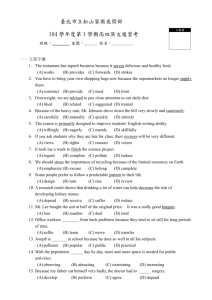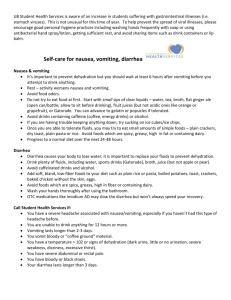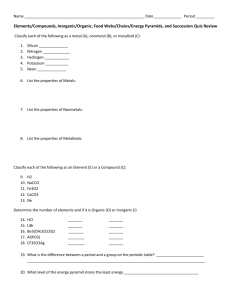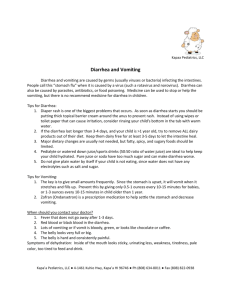Poisonous Plants - The Bird Clinic
advertisement
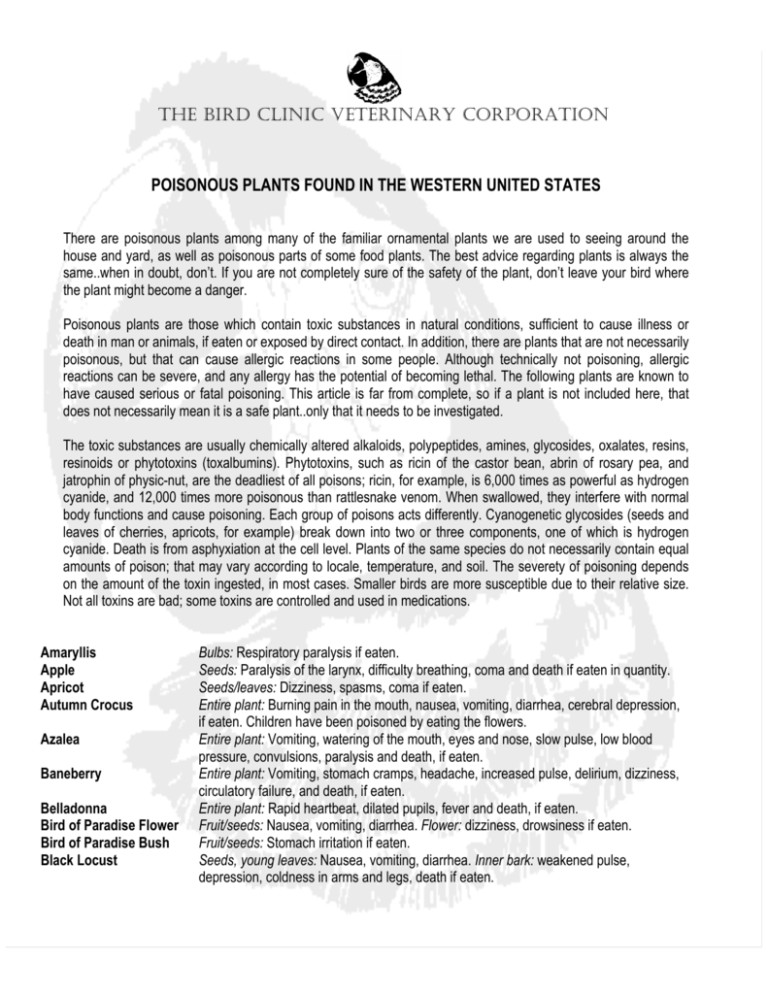
THE BIRD CLINIC VETERINARY CORPORATION POISONOUS PLANTS FOUND IN THE WESTERN UNITED STATES There are poisonous plants among many of the familiar ornamental plants we are used to seeing around the house and yard, as well as poisonous parts of some food plants. The best advice regarding plants is always the same..when in doubt, don’t. If you are not completely sure of the safety of the plant, don’t leave your bird where the plant might become a danger. Poisonous plants are those which contain toxic substances in natural conditions, sufficient to cause illness or death in man or animals, if eaten or exposed by direct contact. In addition, there are plants that are not necessarily poisonous, but that can cause allergic reactions in some people. Although technically not poisoning, allergic reactions can be severe, and any allergy has the potential of becoming lethal. The following plants are known to have caused serious or fatal poisoning. This article is far from complete, so if a plant is not included here, that does not necessarily mean it is a safe plant..only that it needs to be investigated. The toxic substances are usually chemically altered alkaloids, polypeptides, amines, glycosides, oxalates, resins, resinoids or phytotoxins (toxalbumins). Phytotoxins, such as ricin of the castor bean, abrin of rosary pea, and jatrophin of physic-nut, are the deadliest of all poisons; ricin, for example, is 6,000 times as powerful as hydrogen cyanide, and 12,000 times more poisonous than rattlesnake venom. When swallowed, they interfere with normal body functions and cause poisoning. Each group of poisons acts differently. Cyanogenetic glycosides (seeds and leaves of cherries, apricots, for example) break down into two or three components, one of which is hydrogen cyanide. Death is from asphyxiation at the cell level. Plants of the same species do not necessarily contain equal amounts of poison; that may vary according to locale, temperature, and soil. The severety of poisoning depends on the amount of the toxin ingested, in most cases. Smaller birds are more susceptible due to their relative size. Not all toxins are bad; some toxins are controlled and used in medications. Amaryllis Apple Apricot Autumn Crocus Azalea Baneberry Belladonna Bird of Paradise Flower Bird of Paradise Bush Black Locust Bulbs: Respiratory paralysis if eaten. Seeds: Paralysis of the larynx, difficulty breathing, coma and death if eaten in quantity. Seeds/leaves: Dizziness, spasms, coma if eaten. Entire plant: Burning pain in the mouth, nausea, vomiting, diarrhea, cerebral depression, if eaten. Children have been poisoned by eating the flowers. Entire plant: Vomiting, watering of the mouth, eyes and nose, slow pulse, low blood pressure, convulsions, paralysis and death, if eaten. Entire plant: Vomiting, stomach cramps, headache, increased pulse, delirium, dizziness, circulatory failure, and death, if eaten. Entire plant: Rapid heartbeat, dilated pupils, fever and death, if eaten. Fruit/seeds: Nausea, vomiting, diarrhea. Flower: dizziness, drowsiness if eaten. Fruit/seeds: Stomach irritation if eaten. Seeds, young leaves: Nausea, vomiting, diarrhea. Inner bark: weakened pulse, depression, coldness in arms and legs, death if eaten. THE BIRD CLINIC VETERINARY CORPORATION Bleeding Hearts Entire plant: Nausea, vomiting, diarrhea, stomach pains, convulsions and death, if eaten in large quantities. Boxwood Entire plant: Nausea, vomiting, diarrhea, stomach pains, convulsions and death, if eaten in large quantities. Caladiums Entire plant: Burning mouth and throat, swelling of the tongue, choking, nausea, vomiting and diarrhea if eaten. Carolina Jessamine Entire plant: Profuse sweating, convulsions, respiratory arrest and death, if eaten. Castor Bean Entire plant: Nausea, vomiting, burning of the mouth, excessive thirst, diarrhea, stomach pain, dullness of vision, convulsions, uremeia and death in one to twelve days, if eaten. The seeds are more toxic than other parts of the plant. 1-3 seeds can be fatal to a child, eight to an adult. Castor oil, a derivative, is not toxic. Cherries Seeds and leaves: Dizziness, spasms, and coma, if eaten. Chinaberry Tree Berries, flowers and leaves: Nausea, vomiting, diarrhea, paralysis, irregular breathing and symptoms of suffocation if eaten in quantity. Coral Plant Entire plant: Nausea, vomiting, bloody diarrhea, coma and death, if eaten. Crown of Thorns Entire plant: Severe irritation to the mouth, throat and stomach, if eaten. Daffodills Bulbs: Nausea, vomiting, diarrhea, trembling, convulsions, and in some cases, death, if eaten. Datura suaveolens Entire plant: Dry mouth, thirst, hallucinations, delirium, convulsions, coma, death if eaten. Daphnes Berries, flowers, leaves and bark: Burning or ulceration of the stomach and throat, vomiting, internal bleeding with bloody diarrhea, weakness, coma and death, if eaten. Just a few berries can be fatal to a child. Death Camas Entire plant: Nausea, vomiting, diarrhea, stomach pains, slow heartbeat, subnormal body temperature. Delphiniums Entire plant: Stomach upset, nervous condition, depression, and even death, if eaten in quantity. Dumbcane (Diffenbachia) Entire plant: Severe burning in the mouth and throat, swelling of the tongue, choking, vomiting and diarrhea, if eaten or chewed. Elderberries Unripe berries, leaves and wood: Nausea, vomiting, diarrhea if eaten. Children have been poisoned by using whistles made from the wood. The ripe berries are edible and frequently used for wine, pies and jelly. Elephant’s Ear Entire plant: Burning of the mouth and throat, swelling of the tongue, choking, nausea, vomiting, and diarrhea if eaten or chewed. English Laurel Seeds and leaves: Dizziness, spasms and coma if eaten. Fava Bean Seeds: Severe and even fatal hemolytic anemia (Favism) in certain individuals of Italian, Greek or African descent. This inherited trait has been known for centuries and is characterized by a deficiency of glucose-6-phosphate dehydrogenase, and enzyme generally known as G-6-PD. The beans can be eaten without danger by those not carrying this genetic factor. THE BIRD CLINIC VETERINARY CORPORATION Four-O-Clock Foxglove Glory Lily Hollies Horse Chesnuts Hyacinths Hydrangea Ivies Jerusalem Cherry Jimson Weed Lantanas Lily of the Valley Mescal Bean Milk Bush Mistletoe Nightblooming Jasmine Nutmeg Oak Oleander Peaches Philodendron Plums Poinsettia Poison Hemlock Seeds: Nausea, vomiting, diarrhea and stomach pains if eaten. Entire plant: Nausea, vomiting, diarrhea, stamach pains, severe headache, irregular heartbeat, irregular pulse, tremors, convulsions and death, if eaten. Entire plant: Nausea, vomiting, diarrhea, lip and tongue numbness, burning of the mouth, difficulty in breathing, convulsions and death, if eaten. Berries: Nausea, vomiting, diarrhea, and stupor, if eaten. Seeds, flowers, and leaves: Nausea, vomiting, diarrhea, weakness, depression, paralysis, and stupor if eaten. Children have been poisoned by eating the berries. Bulbs: Intense stomach cramps and diarrhea, if eaten. Entire plant: Nausea, vomiting, and diarrhea, if eaten. Berries and leaves: Excitement, difficult breathing and coma, if eaten. Berries: Supposed to be poisonous, but no clear records of poisoning on record. Entire plant: Dry mouth, thirst, nausea, hallucination, delirium, convulsions, coma and death, if eaten. Seeds are more toxic than any other part of plant; 20 seeds will poison an adult. Berries: Circulatory collapse if eaten. Entire plant: Heart stimulation, dizziness and vomiting, if eaten. Seeds: Nausea, vomiting, diarrhea, excitement, delirium, coma, and death, if eaten. One seed is sufficient to cause the death of a child. Entire plant: Severe irritation to the mouth, throat and stomach, if eaten. Berries: Stomach pains, diarrhea, slow pulse, collapse, and death, if eaten. Berries and leaves: Nausea, vomiting, headache, dizziness, hallucinations, nervousness, muscular spasms, and paralysis, if eaten. Seeds: Stomach pains, redness of skin, dry mouth, drowsiness, stupor, hallucinations, double vision, delirium, convulsions, and death, if eaten. As few as two seeds (nutmegs) can be fatal. Acorns: Constipation, bloody stools, damage to the kidneys, if eaten in quantity. Entire plant: Nausea, vomiting, stomach pains, dizziness, slowed pulse, irregular heartbeat, dilation of the pupils, bloody diarrhea, drowsiness, unconsciousness, paralysis of lungs, and death, if eaten. A single leaf is said to be enough to kill an adult and a few flowers, a child. Seeds and leaves: Dizziness, spasms, and coma, if eaten. Entire plant: Burning of the mouth and throat, swelling of the tongue, choking, nausea, vomiting, and diarrhea, if chewed. Seeds and leaves: Dizziness, spasms, coma if eaten. Entire plant: Severe irritation to the mouth, throat, and stomach, if eaten. Entire plant: Nervousness, weakness of the muscles, trembling, coldness, coma, respiratory paralysis, and death, if eaten. THE BIRD CLINIC VETERINARY CORPORATION Potato Privets Rhodendron Rhubarb Sweet Pea Tobaccos Virginia Creeper Water Hemlock Wisteria Yellow Oleander Shoots, fruits (berries), and sun-green tubers: Nausea, vomiting, stomach pain, diarrhea, low body temperature, shock, paralysis, dilated pupils, circulatory and respiratory depression, loss of sensation, and death, if eaten. Berries and leaves: Nausea, vomiting, subnormal temperature, coldness of body, muscular twitching, convulsion and paralysis, if eaten. Children have been fatally poisoned by eating the berries. Entire plant: Vomiting, watering of the mouth, eyes and nose, slow pulse, low blood pressure, convulsions, paralysis, and death, if eaten. Leaf-blades: Nausea, vomiting, stomach pains, weakness, difficulty in breathing, burning of the mouth and throat, internal bleeding, coma, and death, if eaten. The leaves and stalks sold in supermarkets do not contain the toxin and are safe to use. Seeds: Paralysis, if eaten. Entire plant: Nausea, vomiting, retching, stomach pains, diarrhea, colic, muscular weakness, irregular pulse, violent palpitation of the heart, and at times, death. Berries: Thought to be poisonous, but no clear records of poisoning on record. Entire plant: Diarrhea, violent convulsions, tremors, delirium, and death, if eaten. Seeds: Nausea, repeated vomiting, stomach pains, diarrhea, and collapse, if eaten. Two seeds are sufficient to cause serious illness in a child. Entire plant: Nausea, vomiting, heart stimulation, convulsions, and death, if eaten. The fruits are more poisonous than any other part of the plant. One fruit can cause the death of an adult. Many birds and animals are impervious to some of the plants that are toxic to humans. Thus far, a complete list of plants toxic to birds is not available, but this paper will give you an overview of some of the most toxic plants. Some plants, such as Dumbcane, which causes mouth and throat distress in humans has been chewed by birds, and small amounts eaten, with no obvious ill effects. This is not to say it is not harmful, but to point out that some plants may not necessarily be as toxic for birds as for humans. The BIRD Clinic’s recommendation is to use extreme caution when feeding any plant item that is not known to be safe, and supervise your bird when it is in the presence of plants on this list. For example, poinsettia plants should be kept off the floor (for example, on the mantle), unless your bird has free flight, in which case you should not bring these plants into the house. Produced by The BIRD Clinic Veterinary Corporation 2525 N. Grand Avenue, Suite R, Santa Ana, CA 92705 714-633-2910. Website: www.thebirdclinic.net This document may be reproduced with permission only. Revised 6/03

